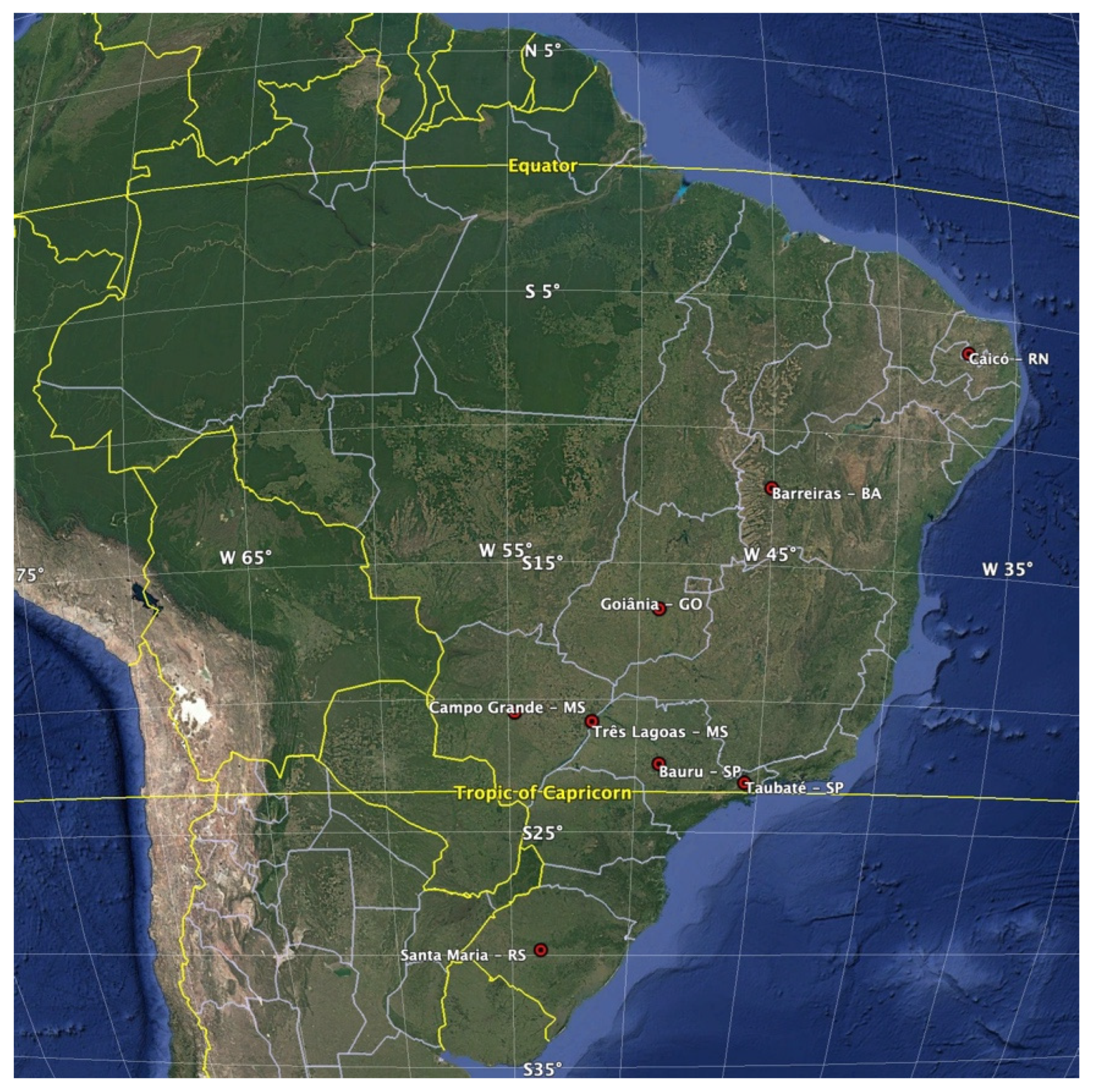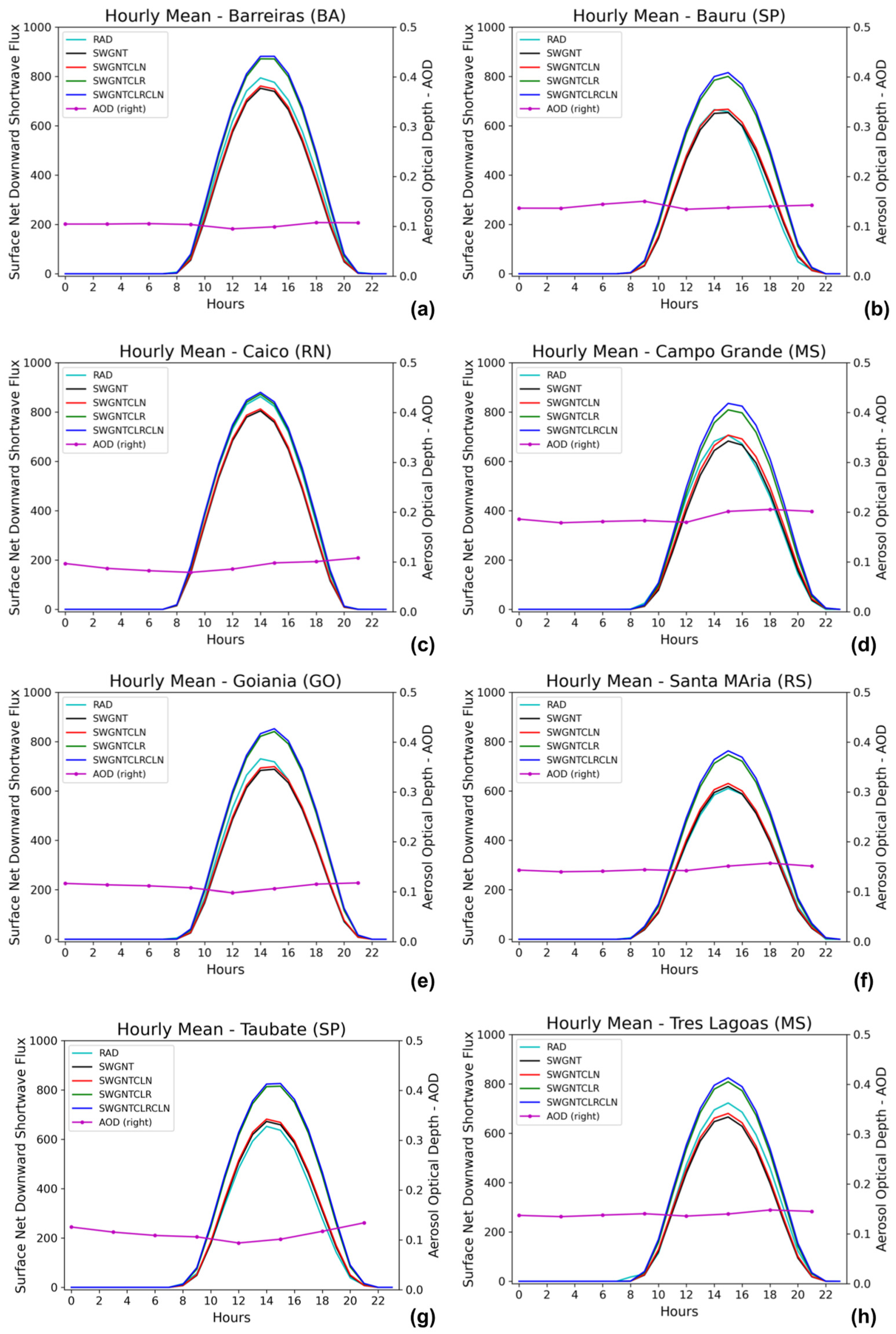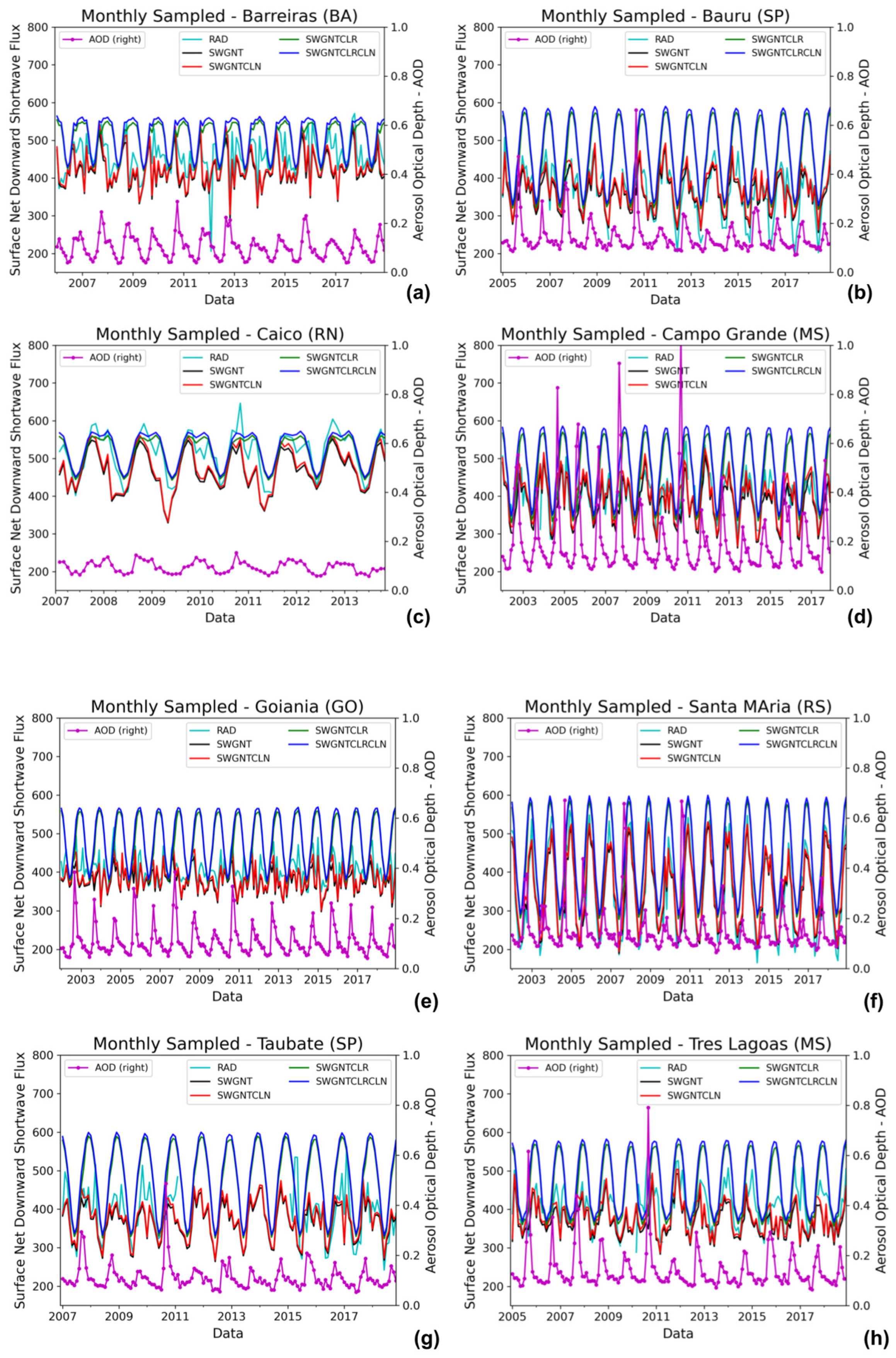The Use of Atmospheric Reanalysis Data for the Estimation of Solar Irradiation Considering the Effect of Atmospheric Aerosols over Brazil
Abstract
1. Introduction
2. Materials and Methods
2.1. Study Region and Observational Data
2.2. Reanalysis MERRA-2
2.3. Statistical Analysis
3. Results and Discussion
3.1. Diurnal Cycle
3.2. Monthly Mean
3.3. Monthly Sampled
3.4. Taylor Plot
4. Conclusions
Author Contributions
Funding
Data Availability Statement
Acknowledgments
Conflicts of Interest
References
- Martins, F.R.; Pereira, E.B.; Abreu, S.L. Satellite-derived solar resource maps for Brazil under SWERA Project. Sol. Energy 2007, 81, 517–528. [Google Scholar] [CrossRef]
- Viana, T.S.; Rüther, R.; Martins, F.R.; Pereira, E.B. Assessing the potential of concentrating solar photovoltaic generation in Brazil with satellite-derived direct normal irradiation. Sol. Energy 2011, 85, 486–495. [Google Scholar] [CrossRef]
- Tiba, C. Atlas Solarimétrico do Brasil; UFPE: Recife, Brazil, 2000; 111p. [Google Scholar]
- Pereira, E.B.; Martins, F.R.; Gonçalves, A.R.; Costa, R.S.; Lima, F.J.L.; Ruther, R.; Abreu, S.L.; Tiepolo, G.M.; Pereira, S.V.; Souza, J.G. Atlas Brasileiro de Energia Solar, 2nd ed.; INPE, Ed.; Instituto Nacional de Pesquisas Espaciais: São Jose dos Campos, Brazil, 2017. [Google Scholar]
- Pereira, E.B.; Abreu, S.L.; Stuhlmann, R.R.; Colle, S. Survey of The Incident Solar Radiation in Brazil by use of Meteosat Satellite Data. Sol. Energy 1996, 57, 125–132. [Google Scholar] [CrossRef]
- Lima, F.J.L.; Martins, F.R.; Costa, R.S.; Gonçalves, A.R.; Souza, J.G.; Pereira, S.V.; Luiz, E.W.; Pes, M.P.; Pereira, E.B. Intercomparação de modelos numéricos para estimativa da irradiação solar em parte do Nordeste brasileiro. Rev. Bras. Energ. Sol. 2018, 9, 79–88. (In Portuguese) [Google Scholar]
- Bellouin, N.; Yu, H. Aerosol–Radiation Interactions. In Aerosols and Climate; Carslaw, K.S., Ed.; Elsevier: Oxford, UK, 2022; pp. 445–487. ISBN 9780128197660. [Google Scholar]
- Albrecht, B.A. Aerosols, Cloud Microphysics, and Fractional Cloudiness. Science 1989, 245, 1227–1230. [Google Scholar] [CrossRef]
- Liu, S.; Chen, M.; Zhuang, Q. Aerosol effects on global land surface energy fluxes during 2003–2010. Geophys. Res. Lett. 2014, 41, 7875–7881. [Google Scholar] [CrossRef]
- Costa, R.S.; Martins, F.R.; Pereira, E.B. Atmospheric aerosol influence on the Brazilian solar energy assessment: Experiments with different horizontal visibility bases in radiative transfer model. Renew. Energy 2016, 90, 120–135. [Google Scholar] [CrossRef]
- Casagrande, M.S.G.; Martins, F.R.; Rosário, N.E.; Lima, F.J.L.; Gonçalves, A.R.; Costa, R.S.; Zarzur, M.; Pes, M.P.; Pereira, E.B. Numerical Assessment of Downward Incoming Solar Irradiance in Smoke Influenced Regions—A Case Study in Brazilian Amazon and Cerrado. Remote Sens. 2021, 13, 4527. [Google Scholar] [CrossRef]
- Feng, F.; Wang, K.C. Merging satellite retrievals and reanalyses to produce global long-term and consistent surface incident solar radiation datasets. Remote Sens. 2018, 10, 115. [Google Scholar] [CrossRef]
- Gelaro, R.; McCarty, W.; Suárez, M.J.; Todling, R.; Molod, A.; Takacs, L.; Randles, C.A.; Darmenov, A.; Bosilovich, M.G.; Reichle, R.; et al. The Modern-Era Retrospective Analysis for Research and Applications, Version 2 (MERRA-2). J. Clim. 2017, 30, 5419–5454. [Google Scholar] [CrossRef]
- Boilley, A.; Wald, L. Comparison between meteorological re-analyses from ERA-Interim and MERRA and measurements of daily solar irradiation at surface. Renew. Energy 2015, 75 (Suppl. C), 135–143. [Google Scholar] [CrossRef]
- Sianturi, Y.; Marjuki, M.; Sartika, K. Evaluation of ERA5 and MERRA2 reanalyses to estimate solar irradiance using ground observations over Indonesia region. AIP Conf. Proc. 2020, 2223, 020002. [Google Scholar] [CrossRef]
- Silveira, C.R.; Luiz, G.C.; Barbosa, G.A.S.; Sousa, L.G.C. Aerosol Influence on Photovoltaic Solar Energy Generation for the State of Goiás (Brazil). Int. Arch. Photogramm. Remote Sens. Spat. Inf. Sci. 2020, 42, 413–418. [Google Scholar] [CrossRef]
- INMET. Instituto Nacional de Meteorologia (INMET). Normais Climatológicas do Brasil de 1991–2020. Disponível em. 2024. Available online: https://clima.inmet.gov.br/NormaisClimatologicas (accessed on 1 February 2024). (In Portuguese)
- Global Modeling and Data Assimilation Office (GMAO) (2015), inst3_3d_asm_Cp: MERRA-2 3D IAI State, Meteorology Instantaneous 3-Hourly (p = coord, 0.625x0.5L42), Version 5.12.4; Goddard Space Flight Center Distributed Archive Center (GSFC DAAC): Greenbelt, MD, USA, 2023. [CrossRef]
- Wilks, D.S. Statistical Methods in the Atmospheric Sciences; Elsevier: Amsterdam, The Netherlands, 2019; p. 840. [Google Scholar]
- Taylor, K.E. Summarizing multiple aspects of model performance in a single diagram. J. Geophys. Res. Atmos. 2001, 106, 7183–7192. [Google Scholar] [CrossRef]
- Farghali, M.; Osman, A.I.; Chen, Z.; Abdelhaleem, A.; Ihara, I.; Mohamed, I.M.A.; Yap, P.-S.; Rooney, D.W. Social, environmental, and economic consequences of integrating renewable energies in the electricity sector: A review. Environ. Chem. Lett. 2023, 21, 1381–1418. [Google Scholar] [CrossRef]
- Jaiswal, K.K.; Chowdhury, C.R.; Yadav, D.; Verma, R.; Dutta, S.; Jaiswal, K.S.; Sangmesh, B.; Karuppasamy, K.S.K. Renewable and sustainable clean energy development and impact on social, economic, and environmental health. Energy Nexus 2022, 7, 100118. [Google Scholar] [CrossRef]
- Vara Vela, A.L.; Herdies, D.L.; Alvim, D.S.; Vendrasco, E.P.; Figueroa, S.N.; Pendharkar, J.; Fernandez, J.P.R. A new predictive framework for Amazon forest fire smoke dispersion over South America. Bull. Am. Meteorol. Soc. 2021, 21, E1700–E1713. [Google Scholar] [CrossRef]
- Herdies, D.L.; Kousky, V.; Ebisuzaki, W. The Impact of High-resolution SALLJEX Data on a Global NCEP Analysis. J. Clim. 2007, 20, 5765–5783. [Google Scholar] [CrossRef]
- Rosario, N.E.; Sena, E.T.; Yamasoe, M.A. South American 2020 regional smoke plume: Intercomparison with previous years, impact on solar radiation, and the role of Pantanal biomass burning season. Atmos. Chem. Phys. V 2022, 22, 15021–15033. [Google Scholar] [CrossRef]
- Alves, N.d.O.; Vessoni, A.T.; Quinet, A.; Fortunato, R.S.; Kajitani, G.S.; Peixoto, M.S.; Hacon, S.d.S.; Artaxo, P.; Saldiva, P.; Menck, C.F.M.; et al. Biomass burning in the Amazon region causes DNA damage and cell death in human lung cells. Sci. Rep. 2017, 7, 10937. [Google Scholar] [CrossRef]
- Marengo, J.A.; Tomasella, J.; Alves, L.M.; Soares, W.R.; Rodriguez, D.A. The drought of 2010 in the context of historical droughts in the Amazon region. Geophys. Res. Lett. 2011, 38, L12703. [Google Scholar] [CrossRef]







| Stations | Latitude | Longitude | Level | Period of Data |
|---|---|---|---|---|
| Barreiras, BA | −12.13° | −45.03° | 474 m | Jan. 2002 to Dec. 2018 |
| Bauru, SP | −22.36° | −49.03° | 636 m | Jan. 2002 to Dec. 2018 |
| Caicó, RN | −6.47° | −37.09° | 171.3 m | Jan. 2007 to Dec. 2019 |
| Campo Grande, MS | −20.45° | −54.72° | 528.5 m | Oct. 2001 to Dec. 2019 |
| Goiânia, GO | −16.64° | −49.22° | 727 m | Jan. 2002 to Dec. 2018 |
| Santa Maria, RS | −29.72° | −53.72° | 103 m | Jan. 2002 to Dec. 2018 |
| Taubaté, SP | −23.04° | −45.52° | 582.3 m | Dec. 2006 to Dec. 2019 |
| Três Lagoas, MS | −20.79° | −51.72° | 329 m | Jan. 2002 to Dec. 2018 |
Disclaimer/Publisher’s Note: The statements, opinions and data contained in all publications are solely those of the individual author(s) and contributor(s) and not of MDPI and/or the editor(s). MDPI and/or the editor(s) disclaim responsibility for any injury to people or property resulting from any ideas, methods, instructions or products referred to in the content. |
© 2025 by the authors. Licensee MDPI, Basel, Switzerland. This article is an open access article distributed under the terms and conditions of the Creative Commons Attribution (CC BY) license (https://creativecommons.org/licenses/by/4.0/).
Share and Cite
Herdies, B.R.; Vendrasco, E.P.; Herdies, D.L.; de Oliveira, C.E.L.; de Quadro, M.F.L. The Use of Atmospheric Reanalysis Data for the Estimation of Solar Irradiation Considering the Effect of Atmospheric Aerosols over Brazil. Atmosphere 2025, 16, 124. https://doi.org/10.3390/atmos16020124
Herdies BR, Vendrasco EP, Herdies DL, de Oliveira CEL, de Quadro MFL. The Use of Atmospheric Reanalysis Data for the Estimation of Solar Irradiation Considering the Effect of Atmospheric Aerosols over Brazil. Atmosphere. 2025; 16(2):124. https://doi.org/10.3390/atmos16020124
Chicago/Turabian StyleHerdies, Bruno Ribeiro, Eder Paulo Vendrasco, Dirceu Luís Herdies, Celso Eduardo Lins de Oliveira, and Mario Francisco Leal de Quadro. 2025. "The Use of Atmospheric Reanalysis Data for the Estimation of Solar Irradiation Considering the Effect of Atmospheric Aerosols over Brazil" Atmosphere 16, no. 2: 124. https://doi.org/10.3390/atmos16020124
APA StyleHerdies, B. R., Vendrasco, E. P., Herdies, D. L., de Oliveira, C. E. L., & de Quadro, M. F. L. (2025). The Use of Atmospheric Reanalysis Data for the Estimation of Solar Irradiation Considering the Effect of Atmospheric Aerosols over Brazil. Atmosphere, 16(2), 124. https://doi.org/10.3390/atmos16020124








